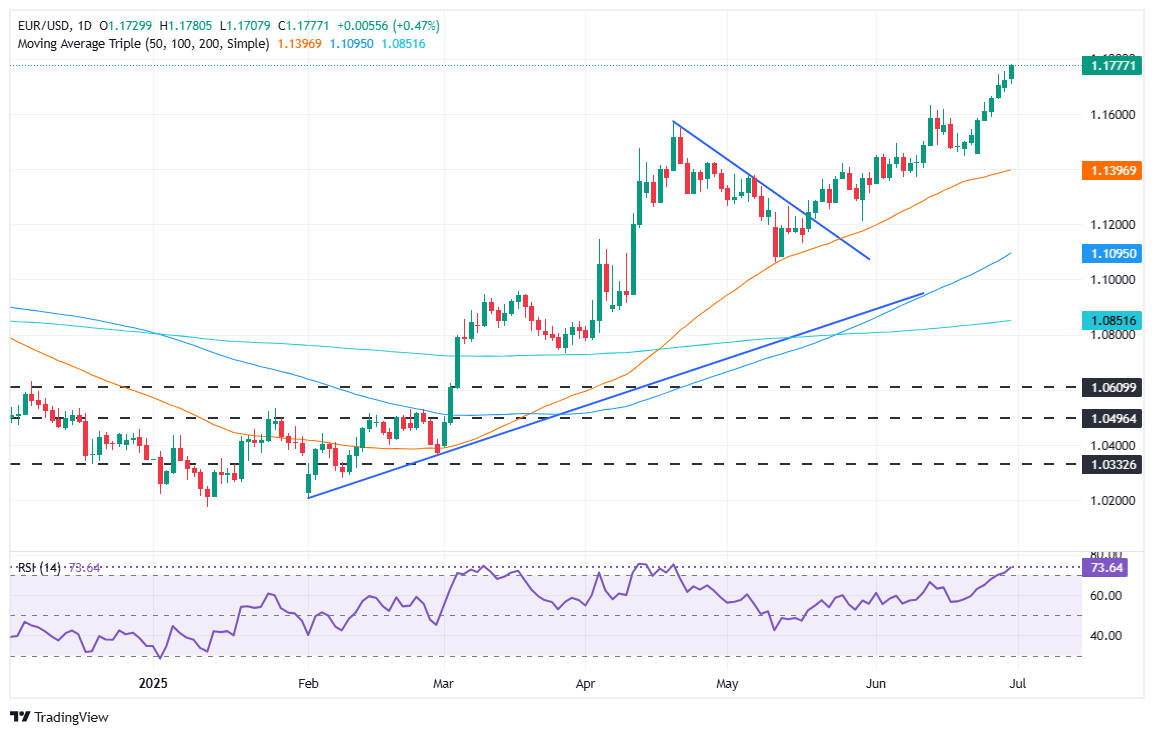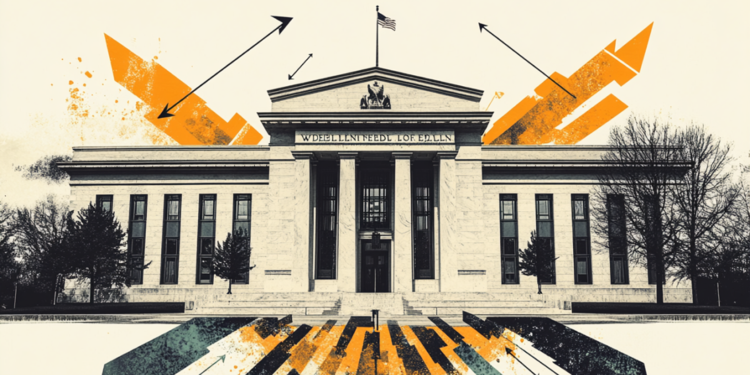- EUR/USD is quoted at 1,1776 after reaching a maximum of several years of 1,1780 amid the weakness of the USD.
- Concerns about the US fiscal deficit and Fed clippings take to the US dollar to a minimum of several years.
- The fall of retail sales in Germany intensifies the growth concerns of the ECB before the key speeches of the central banks.
EUR/USD rises to new annual maximums of 1,1780 on Monday, since the dollar continues to be beaten by the perspectives of approval of the fiscal budget in the United States (USA) and the expectation that the Trump administration continues to progress in commercial agreements with important commercial partners. At the time of writing, the pair is quoted at 1,1776, with an increase of 0.51%.
The feeling remains positive, as indicated by the US shares of shares that register a solid second quarter in 2025, quoting at historical maximums. Therefore, the US dollar (USD) is close to minimums of several years amid expectations that the fiscal deficit will increase substantially, and market participants assessing more than 50 basic points (PB) relief by the Federal Reserve (Fed), promoted the currency shared to a maximum of four years.
The news that the European Union (EU) would accept Trump’s universal tariffs promoted the EUR/USD up. However, the EU wants the US to reduce tariffs in key sectors, including pharmaceutical products, alcohol, semiconductors and commercial aircraft.
The data in Europe revealed that retail sales in Germany fell. Those responsible for the European Central Bank (ECB) seem worried about economic growth and will continue to depend on the data to establish their rate policy.
On Tuesday, the president of the Federal Reserve, Jerome Powell, will share a panel with the president of the ECB, Christine Lagarde, the governor of the Bank of England (BOE), Andrew Bailey, and the head of the Bank of Japan (Boj), Kazuo Ueda.
What moves the market today: the EUR/USD rally continues as the dollar weakens
- EUR/USD seems to be ready to challenge 1,1800. The US dollar index (DXY), which tracks the value of the dollar value against a basket of rivals, drops 0.41% to 96.85, about minimum of almost four years.
- The US fiscal deficit is expected to increase in 3.3 billion dollars if the US Congress approves the “One Big Beautiful Bill” Trump. This could weaken the US dollar and take the euro upwards.
- The US economic agenda is occupied during this short -term. The June Manufacturing PMI is expected to improve 48.5 to 48.8, while it is projected that the change of employment ADP improves 37K private jobs added to the workforce to 85K.
- It is projected that the crucial report of non -agricultural payrolls from the USA shows that the labor market is softening, with estimates that suggest that the economy added only 110,000 people to the workforce, below 139,000 last month. It is projected that the unemployment rate increases from 4.2% to 4.3%.
- Retail sales in Germany in May fell by -1.6% intermensual, below 0.5% expansion estimates. Every year, 2.3% to 1.6% year -on -year fell, and did not comply with the forecast of an increase of 3.3%.
- The ECB Guindos said that the Central Bank faces “a brutal uncertainty”, suggesting that the growth of Q2 and Q3 could be flat and must maintain all open options. The ECB chief economist, Philip Lane, said they could face larger deviations from the 2% inflation target on both sides. Simkus added that they are not sure if they have all the necessary data for the September meeting.
EURO TECHNICAL PERSPECTIVES: EUR/USD ready to test 1,1800 in the short term
The EUR/USD trend remains up, with buyers accumulating more impulse, as indicated by the relative force index (RSI). Although it is in overcompra territory, as indicated by the regular RSI readings, when the trend is strong, a reading between 70-80 suggests an acceleration of the movement before reaching extreme readings. Therefore, a greater rise is expected.
The first supply zone of the EUR/USD would be 1,1800, followed by 1,1850 and 1,1900. On the contrary, if the EUR/USD goes back below 1,1750, look for a drop at 1,1700. A greater decrease is expected if it is exceeded, with the next demand zone in 1,1653, the minimum daily of June 26, before 1,1600.

Euro Faqs
The euro is the currency of the 19 countries of the European Union that belong to the Eurozone. It is the second most negotiated currency in the world, behind the US dollar. In 2022, it represented 31 % of all foreign exchange transactions, with an average daily business volume of more than 2.2 billion dollars a day. The EUR/USD is the most negotiated currency pair in the world, with an estimate of 30 %of all transactions, followed by the EUR/JPY (4 %), the EUR/GBP (3 %) and the EUR/AU (2 %).
The European Central Bank (ECB), based in Frankfurt (Germany), is the Eurozone reserve bank. The ECB establishes interest rates and manages monetary policy. The main mandate of the ECB is to maintain price stability, which means controlling inflation or stimulating growth. Its main tool is the rise or decrease in interest rates. Relatively high interest rates (or the expectation of higher types) usually benefit the euro and vice versa. The GOVERNMENT BOOK of the ECB makes decisions about monetary policy in meetings that are held eight times a year. The decisions are made by the directors of the National Banks of the Eurozone and six permanent members, including the president of the ECB, Christine Lagarde.
Eurozone inflation data, measured by the harmonized consumer prices index (IPCA), are an important economic indicator for the euro. If inflation increases more than expected, especially if it exceeds 2% of the ECB, it forces the ECB to rise interest rates to control it again. Relatively high interest rates compared to their counterparts usually benefit the euro, since they make the region more attractive as a place for global investors to deposit their money.
Published data measure the health of the economy and can have an impact on the euro. Indicators such as GDP, manufacturing and services PMIs, employment and consumer trust surveys can influence the direction of the single currency. A strong economy is good for the euro. Not only attracts more foreign investment, but it can encourage the ECB to raise interest rates, which will directly strengthen the euro. Otherwise, if economic data is weak, the euro is likely to fall. The economic data of the four largest economies in the euro zone (Germany, France, Italy and Spain) are especially significant, since they represent 75% of the economy of the euro area.
Another important fact that is published on the euro is the commercial balance. This indicator measures the difference between what a country earns with its exports and what you spend on imports during a given period. If a country produces highly demanded export products, its currency will gain value simply by the additional demand created by foreign buyers seeking to buy those goods. Therefore, a positive net trade balance strengthens a currency and vice versa in the case of a negative balance
Source: Fx Street
I am Joshua Winder, a senior-level journalist and editor at World Stock Market. I specialize in covering news related to the stock market and economic trends. With more than 8 years of experience in this field, I have become an expert in financial reporting.







